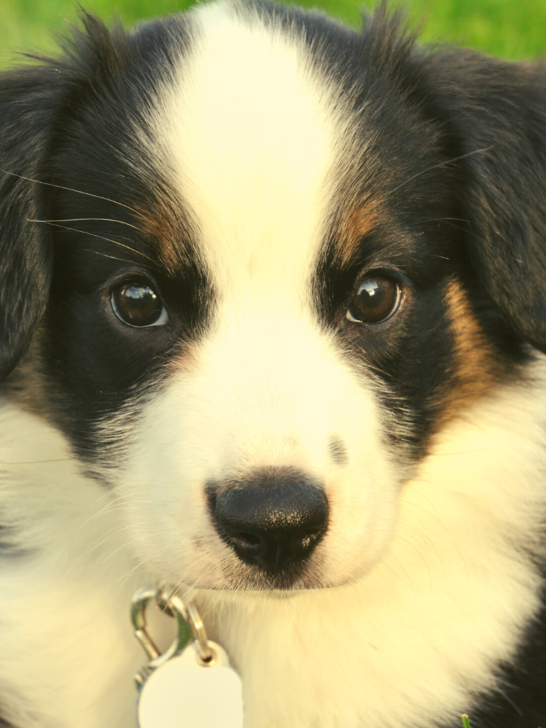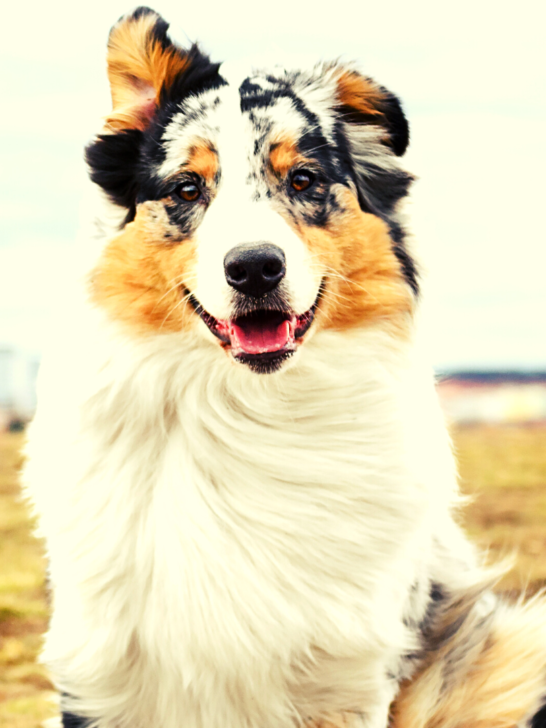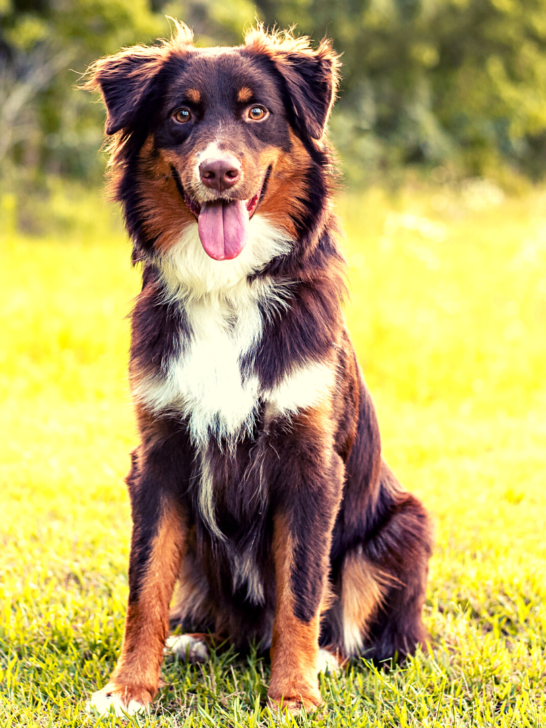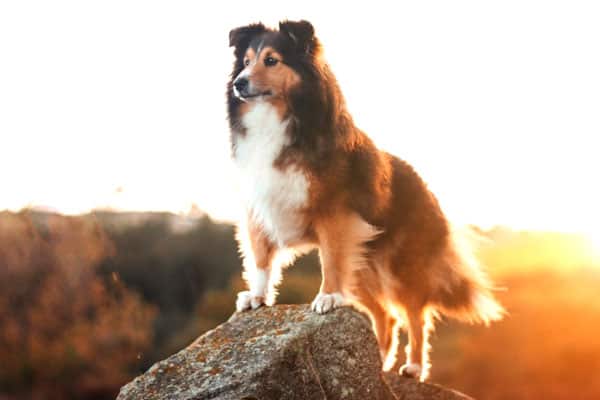Australian Shepherd: How to Plan For the Best Family Dog
If you could have any dog you wanted, what breed would it be? Would you stick with one of the top three choices like the Lab or GSD? Or would you pick a more obscure canid, like the Cesky terrier or English Foxhound?
With 167 AKC-recognized dog breeds and 340 canine varieties acknowledged worldwide, it is difficult to choose one dog. The explosion of favorite designer mixed breeds makes the feat even more overwhelming.
Nevertheless, many people choose the Australian Shepherd as an attractive breed with great pet qualities if his standing as the top 20 most popular breed from 2014 through 2018 is any indication.
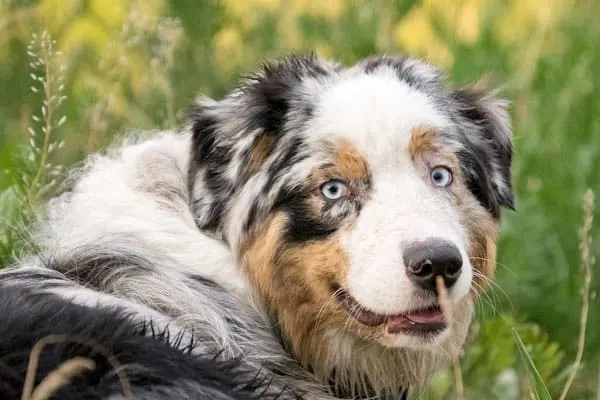
The Australian Shepherd remains in high demand as the preference for more compact dogs increases. Aussies are intelligent, striking canids of the AKC herding group.
You may know Australian Shepherds for their friendliness, speed, nimbleness, and bobtails. Australian Shepherds are generally outgoing without submitting to unnecessary displays of affection outside of the family unit.
Well-socialized Aussies are fantastic pets for active households whether composed of single owners or couples or large families.
Do the Australians have any claim to the Aussie?
The Australian Shepherd had a short stint in Australia, but other than that, its name remains something of a mystery.
When the Australian Shepherd’s ancestors first arrived in the United States in the 1840s, both shepherds and sheep accompanied them from the Great Pyrenees of France and the Basque region of Spain.
Historians think many herders worked in Australia before making the final journey to America. No one knows for certain whether Australian Shepherds gained their name from sheep, dogs, or the native herders from down under.
Nevertheless, the so-called Spanish Shepherd of the time developed in the Rocky Mountains in Colorado under the watchful eye of ranchers as a robust heeler and header of cattle and sheep. Soon after, Australian Shepherds made their way to California where they developed even further.
Aussies retained their adaptations to cold mountainous air, high altitudes, and dry, hot summers. They could undergo long days of work.
In the 1920s, Aussies became attractions of the Western rodeos, both working the circuits with bulls and performing as trick dogs. Three rodeo performers, Queenie, Shorty, and Stubby, skyrocketed the fame of Aussies in the 1950s with handler Jay Sisler.
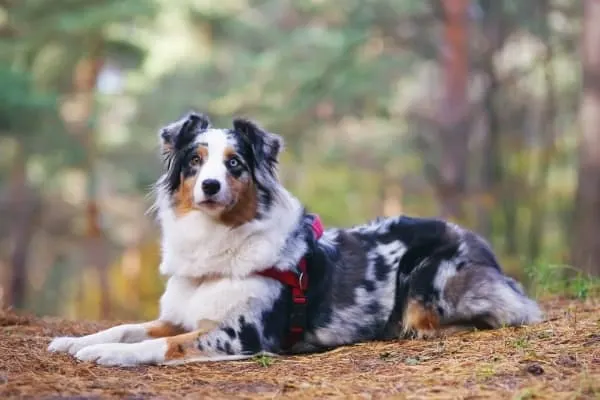
Physical Traits of the Aussie make her attractive and balanced
An Australian Shepherd is a compact, medium dog. The first impression of an Aussie is that of an attentive, bouncy, animated dog with intensity and agility.
Australian Shepherds are 18 to 23 inches tall with females at the lower range. Males weigh 55 to 70 pounds, and females are somewhat smaller at 35 to 55 pounds. Aussies are slightly longer than they are tall with a medium frame.
Almost all the Australian Shepherd’s physical features are medium, including their heads. The skull is in even proportions between the muzzle and rear of the head. The stop should be pronounced without being too steep.
The Aussie’s eyes are medium in size and almond-shaped, reflecting an openly friendly, intelligent, and keen expression. An Aussie’s eyes can be blue, brown, yellow, amber, hazel, or green. All eye colors and combinations are acceptable per the AKC.
Similarly to a Siberian Husky, an Australian can have one eye that is two colors or one blue eye and a brown eye. Aussies also possess eyes that can be different shades such as one amber and one brown eye and eyes that have flecks of colors or a marbled appearance.
An Aussie’s ears are medium and set high, almost semi-prick in some dogs and rose-shaped in others.
About 20% of Aussies have a naturally-occurring bobtail while the remainder born in the US and Canada have their tails docked at a few days old.
Many other countries ban the cosmetic surgical alteration of tails and ears in dogs. An Aussie with a full tail shows feathering and a length extending below the hocks.
Australian Shepherds have a moderate double coat that comes in four base colors with variable presentations. Base colors are black, red, merle, or tricolor.
Red – The liver is called red in Aussies and is recessive to black. Black dogs may carry one copy of the liver gene and are “red-factored.” Breeding two black “red-factored” Aussies will produce about 25% of liver or red dogs.
Red can present as a bicolor (mostly liver with white trim), tricolor (red, white, and copper with varying degrees of white coverage), or red merle. DNA tests can check for the presence of the red factor.
Black – A dominant color in Aussies, you can see black and white, black bicolor (black with minimal white), and black tricolor (black, white, and copper).
Black/Black and tan (same as a gene in German Shepherds) – Black is dominant in Aussies except if carried on the Agouti gene when it is recessive to sable and wolf grey.
Wolf grey and sable do not typically appear in Aussies, so dogs that have double agouti genes usually express as black or black with tan points. Tan is the same as copper in the Australian Shepherd.
Merle – Merle is an incompletely dominant gene. A merle dog with two copies of the dominant gene has many defects, including eye abnormalities leading to blindness and often, deafness.
A normal merle dog has one dominant gene and one recessive copy with normal eyes and hearing. Dogs with two recessive genes will not be merle but can produce merle dogs when bred to a merle.
Blacks are called blue merles, and livers are red merles. Like solid colors, merle dogs can have tan-colored points, or not, and varying degrees of white. Rarely, breeding two merle dogs can result in a mostly white Aussie.
Irish white pattern – The “collie pattern” of white is variable among Aussies.
Merle patch – Genetically different from entirely merle dogs, Aussies with isolated patches of merle do not produce puppies with any defects even if bred to another merle of any variety.
Albino Aussies exist but are rare.
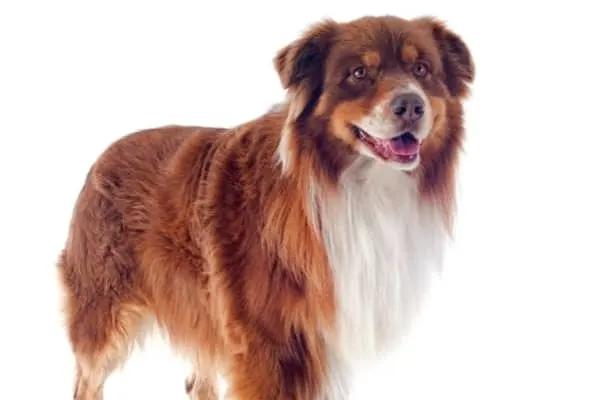
Lethal White Syndrome
Adapted from a genetically similar condition in paint horses, Lethal White Syndrome is a misnomer for the puppies of two merle dogs.
Overo Paint horses when bred together sometimes produce a foal with two dominant genes for Lethal White Syndrome.
The combination of the dominant genes produces a white foal and also causes a fatal digestive disorder. Affected horses do not survive more than a couple of days.
Merle dogs who carry two dominant genes for the marbled coat pattern are not fatally affected. Also, the combination rarely results in a white Australian Shepherd. The more accurate term is the homozygous merle or double merle gene.
According to PetMD, a double merle that results in a mostly white dog with pale blue eyes is a type of albino.
There are three different size varieties
The smaller Australian Shepherds come from selective breeding of small-sized individuals rather than outcrossing with toy breeds.
The miniature Aussie is 15 to 18 inches tall at the withers and weighs between 25 and 40 pounds. The miniature variety became the Miniature American Shepherd in 2010 and gained entry into the AKC as a separate breed of the miscellaneous class in 2012.
Tricolors – Tricolors are red, black, or merle with copper points and white trim.
Toy Australian Shepherds are a mere 10 to 14 inches tall and weigh 12 to 16 pounds. Despite claims of an influx of Papillons and Border Terriers to obtain such a small size, Doggiefetch.com ties the Toy Aussie to two foundational sires, brothers Wildhagen Dutchman and Fieldmaster of Flintridge.
Because breeding Toy Australian Shepherds to each other leads to consistent defects, breeders usually cross Toys with standards. They accept only a portion of the litter will be tiny.
Toy and Miniatures Aussies have the same standards in color, coat, and temperament as normal-sized Australian Shepherds.
Like the standards, Miniature and Toy varieties of the Aussie show gender size variation, with females slightly smaller than males.

Are Australian Shepherds smart?
You probably automatically assume an Australian Shepherd will be smart. After all, herding dogs dominate the top 10 most intelligent dogs list with two in the top three alone.
Australian Shepherds are quick and clever. Despite their similarities to the Border Collie, however, their lack of their close relative’s intuition and sensitivity sets them apart.
Some people miss the sharp responsiveness of Border Collies while others appreciate a less reactionary dog in the Aussie.
According to Animalwised.com and Stanley Coren, a renowned animal psychologist, Australians place a distant 42nd of intelligent dogs compared to the Border Collie’s No.1 rank.
While no test perfectly captures all of the nuances in canine intelligence, Coren’s list takes into account working or obedience, adaptive, and instinctive intelligence to varying degrees. Therefore, dogs will often rank higher on some of Coren’s lists than others.
Aussies received scores based on working intelligence and obedience and scored “medium” in obedience and the cleverness required for their jobs.
If you need a reference, Aussies keep good company with the Kuvasz and Siberian Husky, breeds are known for their independence and lack of automatic obedience.
While most experts do not distinguish canine intelligence based on breeds, Coren’s tests mostly point out the distinctions in trainability among 138 breeds.
Australian Shepherds, according to Smartcanine.com, can readily solve problems on their own but will not be as easy for you to train as several other breeds.
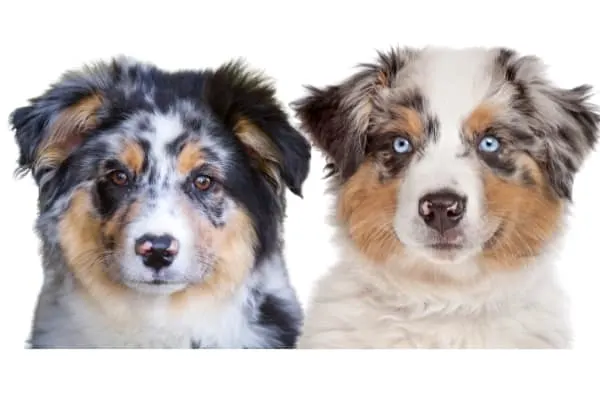
What are the major health concerns?
The AKC requires OFA screening of the hips and elbows and ophthalmology testing before they will certify Aussies. There other recommended criteria, according to USASA Health, are Collie Eye, multiple drug sensitivity, and hypothyroidism genetic tests.
Eyes
As is typical with many breeds related to collies, an Aussie’s eyes seem to be particularly vulnerable to ailments.
Cataracts
Cataracts, a disorder of the lens of the eye, is common in older dogs but can appear in Australian Shepherds as early as one to three years of age.
Colobomas
A coloboma affects the iris or pigmented part of the eye. A developmental disorder, part of the iris is missing, causing the eye to respond to lighting changes improperly. Dogs can potentially suffer discomfort in the sun.
Colobomas appear linked to the merle gene in Aussies. As you will see later, coloboma can be a more general term that also applies to the underdevelopment of other structures of the eye besides the iris.
Progressive retinal atrophy
Fortunately, Aussies are much less susceptible to PRA than other breeds. In Australian Shepherds, PRA is a recessive trait, so both parents must at least carry the gene for a puppy to have any chance of inheriting it.
Health professionals have sought extensive research for genetic testing that consistently screens for PRA, but the mode of inheritance varies among breeds.
Collie eye anomaly (CEA)
While CEA occurs at the rate of up to 95% of Smooth- and Rough-coated Collies in the US, breeders have done a good job of greatly reducing the incidence in Aussies. It is a recessive trait and according to a genetics institute, Ashgi.com, only 0.5% of Aussies will have it although 5% are carriers.
CEA involves the incomplete development of the entire eye with colobomas potentially developing in the optic disc, retina, choroid, and other important eye structures. Additional abnormalities are hemorrhage in the choroid and retinal detachment.
The choroid is a dark layer of the eye that provides blood supply and sits between the sclera and retina. Severe cases of CEA will be blind, and the disease is present at birth.
Autoimmune
Hypothyroidism is an autoimmune inflammatory disease of the thyroid gland. Low thyroid activity is one of the most common hereditary problems in dogs. The disease is easy to treat with supplemental hormones.
Drug Sensitivities
MDR1 drug-related sensitivity is common in many collie-type breeds, including Australian Shepherds. Fifty percent of dogs carry a single copy of the mutated gene, enough to cause a life-threatening neurologic sensitivity to certain commonplace drugs such as dewormers, antibiotics, and antidiarrheals.
Experts recommend you genetically test your Aussie for an MDR1 mutation. If your dog has MDR1 sensitivity, there is a publicized list of all drugs your dog should avoid.
Make sure that list travels with your Aussie and goes into all of her medical records. You can also fit your dog with an MDR1 tag readily visible on her collar.
Cancer
Unfortunately, cancer can be prevalent in older purebred dogs. Australian Shepherds most commonly suffer from two forms of neoplasia.
Hemangiosarcoma
Most frequently originating in the spleen, hemangiosarcoma is a malignant blood-based cancer that can also begin in the skin or heart.
It frequently spreads to the liver and lungs. Radical surgical removal of the initial tumor, including in some cases the spleen, may buy your dog several months.
Lymphosarcoma (Lymphoma)
A disease of the white cells and the lymphatic system, lymphoma often begins as swelling in all of the lymph nodes.
Among the most survivable cancers in dogs, depending upon the stage, lymphoma responds best to chemotherapy protocols.
Orthopedics
Australian Shepherds have relatively healthy joints, but elbow dysplasia shows in about 4% and hip dysplasia in slightly over 6% of Aussies in OFA data from 2019.
Medical professionals may underdiagnose elbow dysplasia, in particular, which has recently been implicated as a causative factor in hip dysplasia.
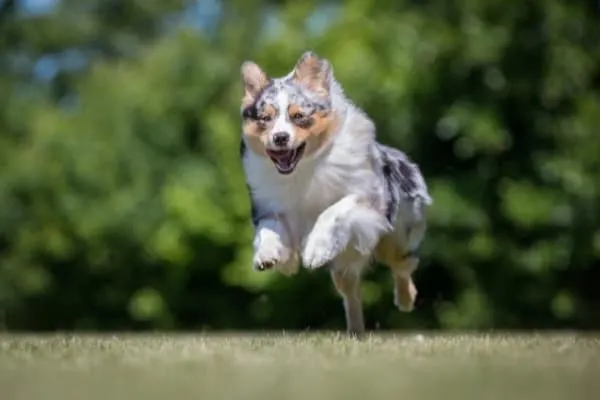
How much exercise should your Australian Shepherd get?
Australian Shepherds have the intensity level, stamina, and working drive equal to such dogs as the German Shepherd and Siberian Husky. Therefore, they require 90 minutes to two hours of exercise every day.
When exercising your dog, your plan should never solely focus on one feature. Exercise should be a comprehensive program that includes segments set aside for mental development, intellectual stimulation, vigorous exercise, and moderate to low-intensity activities.
Mental Development
Mental work should include training throughout your Aussie’s life. When your dog is extremely young, much of his exercises may focus on training and socialization. As he matures, you will still need to reinforce skills you have already taught as well as incorporate advanced lessons.
When attending to your Aussie’s mental well-being, you do not always have to concentrate on the serious work of training.
Often, your dog just needs enrichment because she gets bored with the same routines as you do. Get imaginative with games, or you can invest in puzzles or self-moving electronic toys.
Physical Activities
Physical exercise is what most people think of when they ponder how to provide all their dog’s basic needs.
Indeed, physical activities are essential to keep dogs fit, maintain their muscles, tendons, and joints, and help them cope with excess energy.
Working dogs, especially, usually have more fitness and stamina than they can burn off with a simple walk around the block.
On top of running, jogging, roughhousing in a field with other dogs, or playing Frisbee or fetch, you can engage in some organized activities.
Structured programs that you can perform with your Aussie serve the trifecta of providing mental and intellectual stimulation, strenuous physical exercise, and interactive play.
Agility – With their compact forms, Aussies have the potential to excel at agility. It involves an advanced form of obedience training but with the use of fun tools to test different skills. If you go so far as to compete, most events judge the teamwork between you and your dog.
Shutzehunde – Although originally formulated specifically for the German Shepherd Dog, you can take advantage of Shutzhunde that now tests advanced skills in other breeds. Like in agility, interactions between dog and handler are of paramount importance.
Herding trials – Since Aussie’s herd by eye contact, they naturally fit into herding trials configured with Border Collies in mind. Herding requires extensive training to be successful but can be quite satisfying. Keep in mind, herding competitions and training can utilize livestock other sheep such as ducks, chickens, and geese.
Fly ball – A speed competition that involves a relay between two teams of four dogs each, flyball is a great way to get people together with their friends and other dogs.
Interactive Toys
Self launchers – Dogs can play fetch without you having to undergo the tiresome task of throwing the ball.
Herding balls – Larger in diameter than the dog’s height, herding balls only work by your dog pushing them and chasing them when they finally roll. You can even train your Aussie to perform in competitions called treibball, a German sport whereby they guide herding balls through goals similar to those used for soccer.
Flirt poles – You know what flirt poles are if you have ever used a laser pointer for cats. Some dogs with high predatory drives as well as herding dogs enjoy chasing these points of light.
| Rank | Image | Title | Rating |
|---|---|---|---|
| Best Overall Product |  | IDOGMATE Big Dog Ball Launcher, Tennis Ball Thrower for Big Dogs and mid Sized Dogs | Check Price On Amazon |
| Best Budget Product |  | Chuckit! Classic Ball Launcher, Medium (26 Inch) | Check Price On Amazon |
| Runner-Up |  | Arm & Hammer for Pets Super Treadz Dental Chew Toy for Dogs - Dog Dental Chew Toys Reduce Plaque & Tartar | Check Price On Amazon |
Socialization
Experts’ studies conclude that dogs undergo their most critical social development between six and sixteen weeks, according to Jill Porter/Faithwalk Aussies and Mini American Shepherds.
Of course, socialization efforts do not end when your Aussie turns four months old, but much of your dog’s adult foundation has occurred by this age.
- Loud noises
- People – Various outfits and costumes, ages, and heights
- Animals – As many animals as possible, including different types and ages of dogs as well as birds, donkeys, sheep, goats, and horses wherever possible.
- Places – Once your dog receives 12-week vaccinations, he should go on walks as many locations as you can take her.

Do Australian Shepherds require much grooming?
Aussies have a double coat that consists of medium-length outer guard hairs that are coarser and stiffer than the woolly fleece of their undercoats.
Australian Shepherds have softer fur than some other breeds, with hairs laying relatively flat in mild waves. They often have a ruff of longer fur on chest and neck, “trousers” on the hind legs above the hocks, and “plumes” above the elbows.
Basic tools to groom your Aussie’s coat should include a slicker brush, rake, and bristle brush. People also use pin brushes and defurminator.
| Rank | Image | Title | Rating |
|---|---|---|---|
| 1. |  | Ceenwes Dog Clippers Heavy Duty Low Noise Rechargeable Cordless Pet Clippers Professional Dog Grooming Clippers with Power Status Dog Grooming Kit with 11 Tools For Dogs Cats Other Animals | Check Price On Amazon |
| 2. |  | PawsPamper Undercoat Rake for Dogs & Cats - Proprietary Teeth Angulation for Fast & Pain Free Grooming, Ultra Durable Full Tang Construction | Check Price On Amazon |
| 3. |  | SleekEZ Deshedding Grooming Tool for Dogs, Cats & Horses - Patented Undercoat Brush for Short & Long Hair - Painlessly Remove 95% of Loose Hair, Fur & Dirt | Check Price On Amazon |
A slicker brush is ideal for the outer coat, both before you start on the underfur and as a finishing touch at the end to remove lingering debris.
Use the rake against the growth of the hair to remove dead undercoat that often comes out in tufts. A bristle brush at the very end removes final loose hairs and spreads your dog’s natural oils to give the coat a nice sheen.
You should brush your Aussies at least weekly, but as much as every day during heavy sheds and if your pet is prone to matting.
Australian Shepherds may have a big shedding event in the spring when they shed their undercoat after winter. Indoor Aussies may not have as dramatic of a coat Blowout as those who spend substantial time outdoors in the cold.
Australian Shepherds are year-round moderate shedders. The more you brush him, the more control you can have over your Aussie’s shedding. Baths and soaking your pet’s fur can also decrease shedding in the house, especially when combined with brushing.
Try not to bathe your Aussie more than once a month to avoid skin dryness and irritation. Always use a shampoo with the least possible detergent and formulated for dogs.
You should trim your Aussie’s nails every six to eight weeks. With sufficient exercise, you may notice that you do not need to trim your dog’s every time you check except for the dewclaw, which never touches the ground.
Aussie claws are usually fairly simple to trim as the white color makes the artery quite visible and easy to avoid. Even on gray nails, you can usually readily visualize the quick.
Speak with your veterinarian about oral health. You should get your puppy used to you putting a toothbrush or a finger with a bristled glove in her mouth as most health experts say you should brush your pet’s teeth in her grooming routine.
You’ll also want to be very gentle when doing this during the teething process as well with Aussies.
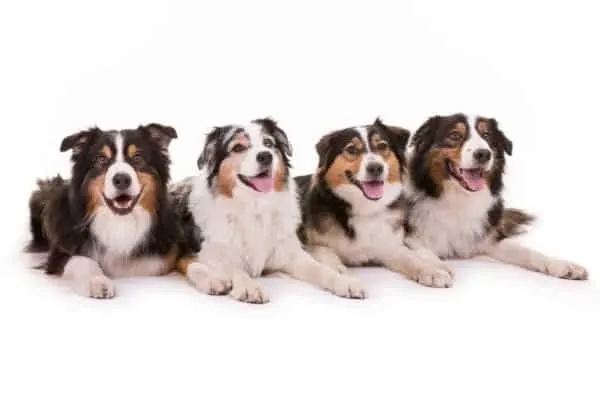
Like many herding breeds, Aussies have multiple uses
– Frisbee – You may hear Frisbee dog and immediately think of Jack Russell Terriers. However, the canine Frisbee champion of the 1970s, according to the AKC, was an Aussie called Hyper Hank. True to their performance heritage, Australian Shepherds have performed Frisbee routines at the Super Bowl.
– Seeing Eye Work – Although not used as commonly as Labradors, GSDs, or Golden Retrievers, Aussies make competent seeing-eye dogs.
The only difficulty, according to Thebark.com, is training them to be mindful of low-hanging overhead obstacles like limbs.
There is also an adjustment to be made for the Aussie’s smaller stature. However, Australian Shepherds are quick to problem-solve their environments.
– Herding – Aussies still move flocks of sheep and herds of cattle in the Western United States
– Search and rescue
– Drug sniffing and mine detection – Aussies are finding more use in scent work as the demand for working dogs increases in the military. They remain overshadowed by in this line of work by German Shepherds, Belgian Malinois, Beagles, and Labrador Retrievers.
– Hearing dog – Dogs can serve a unique role in the lives of hearing-impaired people. Aussies alert people to every day sounds like doorbells and timers with visual cues or physical contact, which their herding backgrounds suit.
– Sports and recreation – Frisbee, agility, treibball, dock diving, fly ball
What is an Australian Shepherd’s herding style?
Aussies have a unique herding style. While we mentioned they utilize eye contact similar to Border Collies, they have a medium- to loose-eyed style whereas their counterparts have a strong to the medium eye and rely on it more exclusively.
Also contrasting Border Collies, Australian Shepherds have a more upright body posture. Most are familiar with the Border Collie’s classic belly-to- the-ground crouch. Strong eye contact is more effective on individuals and tends to be ineffectual on larger animals such as cattle.
Aussies also differ from German Shepherds, who are patrol or continental herders, in that they move herds from place to place as opposed to keeping them within a preordained perimeter.
Their combination of abilities makes Aussies adept at handling large herds of either sheep or cattle. Australian Shepherds can grip at the heels to move herds forward or grip the nose of cattle, for example, to turn them. They typically only utilize eye contact when a sheep or cow challenges them.
Similarly, Aussies do not use grip unless necessary. The dogs accomplish much with posture and body language.
A medium-eyed contact, as opposed to a strong eye, means the dog does not maintain a direct gaze with any part of the animal, employing eye contact mostly under specific circumstances.
The term eye can apply to eye contact with livestock eyes or focus on another body part, such as the heels or ears. Note loose-eyed here does not mean no-eye, whereby a dog does not use his eyes at all to move livestock.
Finally, Aussies differ from strong-eyed dogs in that they use their voices in certain instances to move an entire herd. However, they do not use their bark to the extent of the deep-throated New Zealand Huntaway.
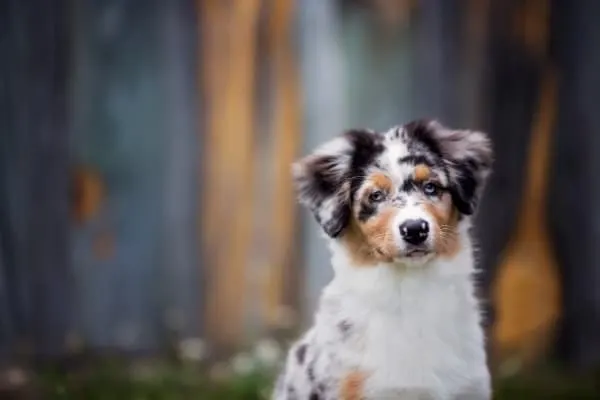
As a family companion Aussies excel
Australian Shepherds are typically friendly with everyone. They are protective of their household without giving any impression of being vicious. Aussies typically bond with all family members.
Other Dogs
Australian Shepherds typically are agreeable with other dogs. As with other dogs, early socialization is crucial for Aussies to develop their naturally friendly tendencies.
Without being taught proper manners, Australian Shepherds can exhibit dominance with fellow dogs.
While many Aussies are generally fine with other animals, some are predatory.
Herding usually reflects several generations of honing a dog’s prey drive, so Aussies may never be completely trustworthy around small animals and cats.
That’s why it’s so important to expose your dog to as many other dogs as possible, if you hope to have a well adjusted puppy that behaves normally in social situations.
Earlier is also better when it comes to getting your dog used to being around others.
If it’s possible to have a second Aussie join your home, that’s even better.
When this is done properly, Australian Shepherds are generally great with other dogs, and benefit a lot from having that constant companionship.
Children
Australian Shepherds are in the same category as Border Collies and Corgis when it comes to nipping in the attempt to herd children.
Supervision around children under nine years old is necessary because Aussies can sometimes exhibit dominance or pushiness with younger kids.
Strangers
Australian Shepherds are often extroverted and friendly with people they perceive as your guests but can also be polite or reserved more like the GSD.
Even friendly Aussies do not usually have much interest in nonfamily members taking liberties such as petting them.
If you have an Australian Shepherd, you will likely experience a dog with fair to good guarding instincts. While not particularly aggressive dogs, Australian Shepherds are suspicious against uninvited strangers and provide an effective deterrent with sharp barking.
You should socialize your Aussie to prevent shyness.
The athleticism of Australian Shepherds
Herding Sheep
This illustrates the herding style of the Australian Shepherd. Note how effective the Australian Shepherd is at keeping a large flock of sheep together and moving in a uniform and calm manner without appearing exceptionally vigilant.
The dog has an intermittent gaze on the sheep and steady communication with the handler with eye contact. A loose eye often allows livestock to relax while the strong eye of a Border Collie will keep sheep on edge as if there is always a predator nearby.
Border Collie
For illustrative purposes only, not to imply one style is better than the other, this is a strong-eyed dog. Note when the Border Collie works with the sheep, she keeps her eyes consistently on the target.
Her low posture and quick movements keep the sheep on high alert. You will notice this dog can keep a further distance from the livestock than the loose to the moderate-eyed dog above, but the sheep never relax in her presence.
Ducks
This is a red merle tricolor with white trim and copper points. In both Aussie examples, you can note how effortlessly the dogs work to keep the flocks together, and communication is with an extremely low headset. Attention to the handler is consistent, and control of livestock is through body language and a loose eye.
Agility
Agility is not all about competition but also illustrates the interaction between dog and owner and the importance of effective communication.
Also notice the Aussie’s athleticism, speed, and nimbleness. You can observe a blue merle tricolor dog with a possibly natural bobtail.
Australian Shepherd Temperature Tolerance
Australian Shepherds have thick double-layered coats that do much more than give the Aussie a striking appearance.
Although it can be tempting to trim their coats when their fur gets out of control bushy and long, you really need to be careful.
It’s important not to trim their coats down too much or too often, since this is what keeps your dog warm in cold weather and cool in hot weather.
Although Aussies originated in areas with more temperate climates, they have evolved to be able to live in hot weather as well.
This is thanks to their coat’s ability to shed more than usual in preparation for summer, and to do the opposite for cold weather.
In fact, the Australian Shepherd heat tolerance is now high enough that they can live in some of the world’s hottest places like Florida and even India.
The Aussie’s ability to utilize its double-layered coat explains its history of living in cool and hot weather conditions.
















